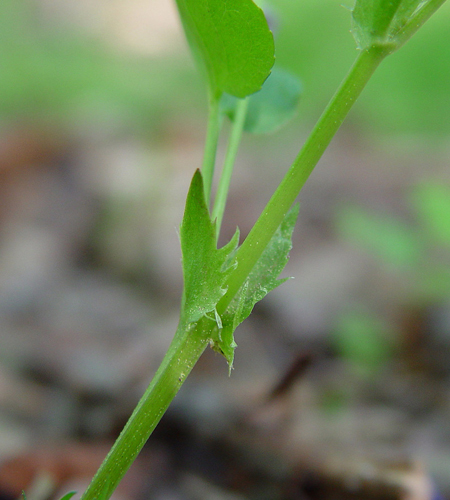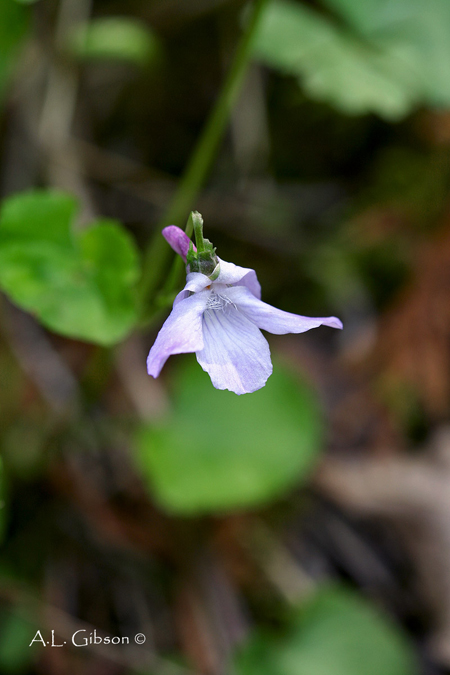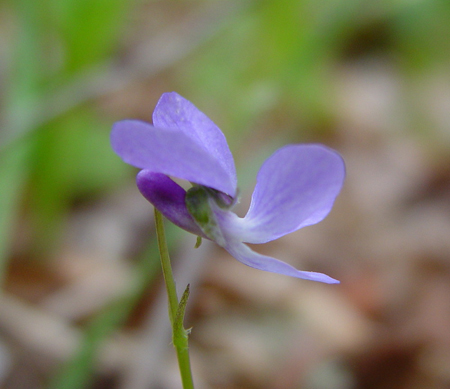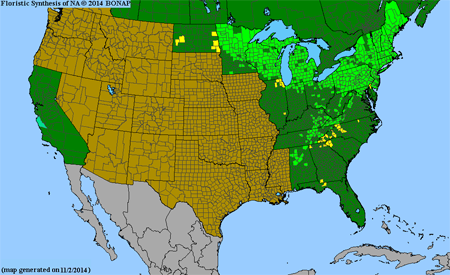Viola labradorica Schrank
Common names:
American Dog Violet, Labrador Violet
Synonyms:
Viola labradorica Schrank, Denkschr. Bot. Ges. Regensb. 1(2): 12. 1818. TYPE: "New Greenland" [Labrador], [no date], Kohlmeister s.n. (HOLOTYPE: M0112897!, internet image!). [Schrank described this from a specimen, collected by a missionary friend named Kohlmeister, and deposited in the Schreber Herbarium in M.]
Viola debilis Michx. f. muhlenbergii (Torr.) Farw., Amer. Midl. Naturalist 12: 68, 128. 1930; Viola canina Walter var. muhlenbergii (Torr.) A.Gray, Bot. Gaz. 11(11): 292. 1886; Viola muhlenbergii Torr., Fl. n. middle United States 1(2): 256. 1824
Viola leucopetala Greene, Ottawa Naturalist 15: 191. 1901
Viola conspersa Rchb., Iconogr. bot. pl. crit. 1: 44. 1823
Viola punctata Schwein., Amer. J. Sci. 5: 67. 1822 [illegitimate homonym of Viola punctata (Humb. & Bonpl.) Schult. (1819)]
Viola adunca Sm. var. minor (Hook.) Fernald, Rhodora 51: 57. 1949; Viola muhlenbergiana Ging. var. minor Hook., Fl. bor.-amer. 1: 78. 1830; Viola debilis Pursh, Fl. Amer. sept. 1: 174. 1813
Description:
Caulescent perennials from somewhat slender rhizome, stems ascending in flower but commonly reclining in fruit, commonly ≥ 2, ≤ 25 cm tall; stems, foliage and peduncles light to medium yellow-green, glabrous except for scattered short appressed hairs on upper surface of leaf blades; leaves cauline and basal, cauline distributed along stem; stipules free, weakly lacerate; leaves ascending or spreading, leaf blades undivided, largest ≤ 31 × 29 mm, broadly ovate or suborbicular to reniform, base deeply cordate, margins crenate, eciliate, apex broadly rounded to obtuse or apiculate, rarely acutish; chasmogamous flower ≤ 17 mm; calyx glabrous, eciliate; lowest sepals lanceolate to linear-lanceolate, acuminate to narrowly obtuse; auricles short and entire, not elongating in fruit; corolla pale to medium blue, throat white; spur moderately elongate, slender, 4&ndash8 mm, white to pinkish, violet or blue; lateral petals densely bearded with narrowly linear hairs, spurred petal glabrous; cleistogamous flowers produced after chasmogamous; capsule 3–6 mm, green drying tan, unspotted or with fine red spots or lines, glabrous; seeds 1.5–2.0 × 0.8–1.1 mm, medium-brown, unspotted; 2n=20.
Similar species:
This species might be confused with the caulescent habit and white to sometimes pale violet flower of the newly confirmed Asian introduction Viola arcuata if the deltate-ovate to deltate-reniform leaf blades and entire or minutely toothed stipules of the latter were ignored, but the few fine nectarguide-lines on the spurred petal and the longer spur would differentiate V. labradorica. It is similar to V. appalachiensis in general foliage and pubescence characters, pale blue corolla with moderately long spur, and weakly lacerate stipules, but it is not mat-forming and the stems are annually deciduous.
Ecology:
Moist to wet loamy, peaty or mucky soils in mesic to wet-mesic forests, alluvial woods and swamps, seepage slopes, marl ravines, and hammocks.
Distribution:
Widely distributed in ne. North America and Appalachian Mountains, extending southward, and in boreal western North America, GL and NL to NT, south to MD, OH, n. IL, ND and AB, in the Appalachians to AL and TN, disjunct in sw. GA and the panhandle of FL.
Rarity:
None.
Phenology:
Chasmogamous flower March–July (September), chasmogamous fruit June–August (September), cleistogamous fruit August–September.
Affinities:
This species belongs to the Rostrate Violet lineage, sect. Viola, subsect. Rostratae (Kupffer) W.Becker.
Hybrids:
Hybridizes with V. adunca (Brainerd 1924, Ballard 1992, Ballard 1995, Haines et al. 2011), V. rostrata (Malte & Macoun 1915, Brainerd 1924, House 1924, Henry 1953a, Scoggan 1978, Ballard 1990a, 1992, 1995, Haines et al. 2011), V. striata (Gaiser and Moore 1966, Ballard 1990b, 1992, 1995, Haines et al. 2011), and V. walteri (Ballard 1992, 1993). I have observed the hybrids and have found the features of chasmogamous flowers and foliage to be more or less precisely intermediate. Hybrids fail to reproduce by chasmogamous flowers, and cleistogamous capsules fail to produce viable seeds.
Comments:
Brainerd (1921b), Brainerd Baird (1942), Fernald (1950), Henry (1953a), Jørgensen et al. (1958), Alexander (1963), Russell (1965), Scoggan (1978), Strausbaugh and Core (1978), Swink and Wilhelm (1979), and Gleason and Cronquist (1991) recognized a predominately temperate eastern North American V. conspersa Rchb. separate from a boreal taxon with smaller size and "subentire" stipules. Brainerd, Jørgensen, and Russell maintained the boreal violet as V. labradorica Schrank, while Fernald, Alexander, Scoggan, and Gleason and Cronquist referred the boreal taxon to V. adunca var. minor (Hook.) Fernald. Glabrous or glabrate plants of V. adunca differ in many vegetative and floral traits from plants of V. labradorica from throughout the range of the latter species. Nevertheless, when Fernald (1950) made the combination V. adunca var. minor, he synonymized under it the names V. labradorica Schrank, V. muhlenbergiana Ging. var. minor Hook., V. adunca Sm. var. glabra Brainerd, and V. adunca f. glabra (Brainerd) G.N.Jones, effectively combining all glabrous or glabrate northern Rostrate violets under his new combination. Ironically, Hooker cited V. debilis Pursh as a synonym under V. muhlenbergiana var. minor, and Pursh's description clearly refers to the temperate violet previously known as V. conspersa. Fernald consequently made the dual error of combining two taxa that were not conspecific and also misapplying the new name, V. adunca var. minor, to boreal populations attributed by others to V. labradorica sensu stricto. Alexander, Scoggan, and Gleason and Cronquist perpetuated this unfortunate compounded mistake. Morphometric studies of floral, stipule and leaf blade traits, and examinations of styles, on numerous herbarium specimens from the ranges of V. labradorica and V. conspersa (Ballard 1992) revealed a continuum indicating a single taxon. The earliest available name is used here. This merger has been adopted by Ballard (1995, 2000), McKinney and Russell (2002), Haines et al. (2011), Voss and Reznicek (2012), Weakley et al. (2012), and Little and McKinney (2015). Little and McKinney reference specimens named this in CO and note that some taxonomists have treated it as synonymous with V. bellidifolia in that state, apparently perpetuating the unnecessary confusion between the V. adunca complex and the present species. The names V. conspersa Rchb. var. masonii Farw., f. masonii (Farw.) House, and V. adunca Sm. f. masonii B.Boivin are all based on a type that is V. striata Aiton (Ballard 1995).
Literature Cited:
Alexander, E. J. 1963. Violaceae. In Gleason, H. A., The new Britton and Brown illustrated flora of the northeastern United States and adjacent Canada. Hafner Publishing Co., Inc., New York, NY. 552-567.
Ballard Jr., H. E. 1990a. Hybrids among three caulescent violets, with special reference to Michigan. Michigan Botanist 29: 43-54.
Ballard Jr., H. E. 1990b ["1989"]. Viola ×eclipes, a new hybrid violet. Michigan Botanist 28: 216-219.
Ballard Jr., H. E. 1992. Systematics of Viola section Viola in North America north of Mexico. M.S. thesis. Central Michigan University, Mount Pleasant, MI.
Ballard Jr., H. E. 1993. Three new rostrate violet hybrids from Appalachia. Castanea 58: 1-9.
Ballard Jr., H. E. 1995 ["1994"]. Violets of Michigan. Michigan Botanist 33: 131-199.
Ballard Jr., H. E. 2000. Violaceae. In Rhoads, A. (ed.). Flora of Pennsylvania. University of Pennsylvania Press, Philadelphia, PA. 700-710.
Brainerd, E. 1921b. Violets of North America. Vermont Agricultural Experiment Station Bulletin 224: 1-172.
Brainerd, E. 1924. The natural violet hybrids of North America. Vermont Agricultural Experiment Station Bulletin 239.
Brainerd Baird, V. 1942. Wild violets of North America. University of California Press, Berkeley, CA.
Fernald, M. L. 1950. Violaceae. In Gray’s Manual of Botany, 8th ed. American Book Company, New York, NY. 1022-1042.
Gaiser, L. O., and R. J. Moore. 1966. A survey of the vascular plants of Lambton County, Ontario. Plant Res. Inst. Can. Dept. Agric. Ottawa, Ont. 122 pp.
Gleason, H. A., and A. Cronquist. 1991. Violaceae. In Manual of vascular plants of northeastern United States and adjacent Canada, 2nd ed. New York Botanical Garden, Bronx, NY. 157-163.
Haines, A., E. Farnsworth, and G. Morrison. 2011. Violaceae. In Flora Novae Angliae. Yale University Press, New Haven, CT. 873-886.
Henry, L. K. 1953a. The Violaceae in western Pennsylvania. Castanea 18(2): 37-59.
House, H. D. 1924. Annotated list of the ferns and flowering plants of New York state. Family 83 Violaceae. New York State Museum Bulletin 254: 499-512.
Jørgensen, C. A., T. Sørensen, and M. Westergaard. 1958. The flowering plants of Greenland–A taxonomical and cytological survey. Biol. Skr. 9(4): 1-172.
Little, R. J., and L. E. McKinney. 2015. Violaceae. In Flora of North America: Cucurbitaceae to Droseraceae, 106. Oxford University Press, New York, NY.
Malte, M. O. and J. Macoun. 1915. Hybridization in the genus Viola. Ottawa Naturalist 28(11): 145-150, 161-168.
McKinney, L. E., and N. H. Russell. 2002. Violaceae of the southeastern United States. Castanea 67: 369-379.
Russell, N. H. 1965. Violets (Viola) of the central and eastern United States: An introductory survey. Sida 2: 1-113.
Scoggan, H. J. 1978. Violaceae. In Flora of Canada, Part 3–Dicotyledoneae (Saururaceae to Violaceae). National Museums of Canada. Ottawa, Canada. 1103-1115.
Strausbaugh, P. D., and E. L. Core. 1978. Violaceae. In Flora of West Virginia, 2nd ed. Seneca Books, Inc., Morgantown, WV. 644-658.
Swink, F., and G. Wilhelm. 1979. Violaceae. In Plants of the Chicago region, 2nd ed. revised and expanded. Morton Arboretum, Lisle, IL. 384, 801-810.
Voss, E. G., and A. A. Reznicek. 2012. Violaceae. In Field manual of Michigan flora. The University of Michigan Press, Ann Arbor, MI. 913-922.
Weakley, A. S., J. C. Ludwig, and J. F. Townsend. 2012. Violaceae. In Flora of Virginia. BRIT Press, Fort Worth, TX. 963-975.

Chasmogamous flowering habit by Arthur Haines, "Go Botany" website, Native Plant Trust

Chasmogamous flowering habit by Andrew Gibson, "Buckeye Botanist" website

Stipules by Arthur Haines, "Go Botany" website, Native Plant Trust

Chasmogamous flower front view by Arthur Haines, "Go Botany" website, Native Plant Trust

Chasmogamous front view by Andrew Gibson, "Buckeye Botanist" website

Chasmogamous flower profile view by Arthur Haines, "Go Botany" website, Native Plant Trust

Map by the Biota of North America Program